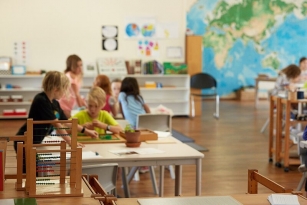
Montessori Classrooms
Montessori classrooms, or Prepared Environments, are designed to meet the physical and psychological needs of the child at each stage of development. In Montessori, the curriculum is embedded within a learning environment or classroom, in the form of a carefully designed and sequenced range of hands-on learning materials and activities. Montessori materials are designed to stimulate the child into logical thought and discovery.
The beauty, order and accessibility in the classroom serve to entice the child into activity. Guided by the Montessori teacher, the child explores the materials independently, and this is when the learning occurs. Children are able to engage with the activities according to their individual interests and at their own pace. In this way learning becomes highly personalized.
The Montessori classroom is not merely a place for individual learning. It is a vibrant community of children, where the child learns to interact socially in a variety of ways. The three-year age range enables older children to teach the younger and learn much themselves from the experience while the younger children are inspired to more advanced work through observing the older ones. With such a variety of levels in the classroom, each child can work at his or her own pace, unhindered by competition and encouraged by co-operation. Children attend daily and for a three-year cycle.
Key Principles of the Prepared Environment
Independence – the environment must be prepared to enable the child to become physically independent of the adult. Because he is able to do things for himself he starts to be able to choose and decide things for himself. The environment must allow for this both in the way that the materials are prepared and in the approach of the adults.
Indirect preparation – although activities are prepared with their own developmental aim in mind they also prepare for something that will come later in the child’s development. Sometimes this preparation is for something that will occur in the same plane but it also refers to something that may occur much later in the child’s life e.g. the sensorial base for mathematical understanding in the abstract, or moral development.
Order – order is something that pervades a Montessori environment. For the small child in the Children’s House the physical order of the prepared environment is obvious but order also underlies all of the less tangible aspects of the environment e.g. the consistency of the adults and their approach, the order of presentation etc. For the older child the social order becomes more important.
Choice – the environment must give the child the opportunity to choose what he does from a range of activities that are suitable to his developmental needs.
Freedom – essential to the prepared environment is the child’s freedom – to choose, to work for as long as he wants to, to not work, to work without being interrupted by other children or by the constraints of a timetable etc. – as long as his activity does not interfere with other children’s right and freedom to do the same.
Mixed Age Range – another non-negotiable part of the environment is the formation of a community with at least a three-year age range, This allows for children to learn from each other in a non-competitive atmosphere and directly prepares the child for living in society.
Movement – the environment must allow the child’s free movement so that he can exercise his freedom to bring himself into contact with the things and people in his environment that he needs for his development.
Control of Error – the environment and in particular the materials should be prepared in a way that allows the child to become aware of his mistakes and to correct them for himself so that he understands that it is all right to be wrong and that we can learn from our mistakes.
Materials – the materials that we choose for the environment must act as keys to the child’s development and we need to prepare the environment with this in mind. The keys we choose will be directed by the child’s essential developmental needs at each age range.
Role of the Adult – the adult is also part of the Montessori environment. The role of this adult is not like the teacher in a traditional environment, however – whose role is to teach the children. The role of the adult in a Montessori environment is to facilitate the child to teach himself by following his own internal urges that will lead him to take what he needs from the things and people around him.